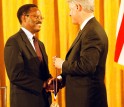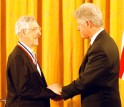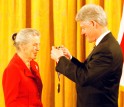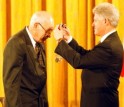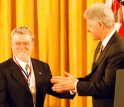Fact Sheet
"Vital Statistics" of the Awardees of the 1998 National Medal of Science
December 8, 1998
This material is available primarily for archival purposes. Telephone numbers or other contact information may be out of date; please see current contact information at media contacts.
Behavioral and Social Sciences | Biological Sciences | Chemistry | Engineering | Mathematics | Physical Sciences
BEHAVIORAL AND SOCIAL SCIENCES
Who: William Julius Wilson, Lewis P. and Linda L. Geyser University Professor, John F. Kennedy School of Government, Harvard University
What: Wilson's approach to studying urban poverty has encouraged a broader point of view with respect to the interactions of race, class and location, and has influenced further research in the field by a generation of social scientists.
Why: Wilson revitalized the field of urban sociology, pioneering methods of interdisciplinary social science research, advancing understanding of the interaction between the macroeconomic, social structural, cultural and behavioral forces that cause and reproduce inner city poverty. Author of five important books, The Truly Disadvantaged, is Wilson's most influential. In it, he laid out a new set of hypotheses about why inner city poverty had been getting worse, and he mapped a new research agenda on the subject. Research on what has increasingly come to be known as the"underclass" has since focused largely on this agenda. His now classic account in The Truly Disadvantaged: The Inner City, The Underclass, and Public Policy, explains the social dislocations caused by the massive loss of employment opportunities in the inner city, and it has framed ever since, scholarship in urban poverty. His guiding hypotheses about the relationships among urban industrial decline, black job loss, residential segregation and the problems of family instability and communal dysfunction have stimulated a new generation of social, economic, anthropological and psychological research.
Personal: Doctorate in sociology/anthropology, Washington State University. M.A. in sociology/history, Bowling Green State University, Ohio. Bachelor of Arts in sociology/history, Wilberforce University, Wilberforce, Ohio. Born in Derry Township, Penn., Dec. 20, 1935.
Who: Bruce N. Ames, professor of biochemistry and molecular biology and Director, National Institute of Environmental Health Sciences Center, University of California, Berkeley
What: Ames changed the direction of basic and applied research on mutation, cancer and aging. He devised a simple, inexpensive test for environmental and natural mutagens, identified causes and effects of oxidative DNA damage and translated these findings into intelligible public policy recommendations on diet and cancer risk for the American people.
Why: Ames' contributions have had direct application to the evaluation of environmental and natural mutagens. The validity of a simple test to measure the production of mutations in bacteria has been confirmed by rigorous quantitative comparisons with data available from animal tests. He recognized the preponderance of natural chemicals that have mutagenic potential, and devised a quantitative index to order these chemicals. Dr. Ames' work on endogenous DNA damage and its role in aging and cancer is likely to have an even larger impact. In a series of major papers and reviews, he presented evidence that endogenous oxidants are important in damaging DNA. He developed an innovative method for measuring oxidative DNA damage in individual humans by measuring DNA repair products excreted in urine. His work represents a singular example of the application of basic research to health and public policy issues.
Personal: Doctorate in biochemistry from the California Institute of Technology. Bachelor's degree in chemistry from Cornell University. Born in New York, N.Y., Dec. 16, 1928.
Who: Janet D. Rowley, Blum-Riese Distinguished Service Professor, University of Chicago
What: Rowley has revolutionized cancer research, diagnosis and treatment through her discovery of chromosomal translocations in cancer, and in her pioneering work on the relationship of prior treatment to recurring chromosome abnormalities. Her work epitomizes the "bench to bedside" philosophy in the application of basic discoveries to clinical medicine.
Why: Almost immediately after technical methods for examining human chromosomes were developed in the late 1950's, Rowley began applying those methods to the analysis of leukemia cells. She identified visible rearrangements, some of which where characteristic of a particular variety of cancer. In 1972, Dr. Rowley discovered the first two recurring chromosome translocations identified in any human cancer, and subsequently went on to characterize six other translocations and inversions which are commonly observed in various types of leukemia. Rowley's discovery of recurring chromosome translocations resulted in a paradigm shift that has had an ever-broadening impact on basic cell biology and on clinical cancer research.
Personal: M.D., Bachelor of Science and Ph.B., from the University of Chicago. Born Apr. 5, 1925, in New York, N.Y.
Who: John W. Cahn, Fellow, National Institute of Standards and Technology, Gaithersburg, MD
What: The world's intellectual leader in a broad range of the materials science, Cahn had a profound influence on the course of materials and mathematics research, and had an immense impact on three generations of materials scientists, solid-state physicists and mathematicians.
Why: Throughout a 40-year career, John Cahn developed pioneering theories on how materiakls transform from one phase to another under conditions of changing stress, temperature and material composition. Time and again, he has been the first to recognize a fundamental materials problem and to propose a breakthrough solution that encompasses all the important physics and extends the limits of what is known in mathematics. His fundamental approaches have generated new scientific fields which have expanded our understanding of the behavior of engineering materials. Cahn is most widely known for the discovery and analysis, along with Shechtman, Blech, and Gratias, of a quasi-periodic solid. This discovery by Cahn and his coworkers in 1984 sparked a revolution in crystallography. Now known as "quasi-crystals," this was one of the most important scientific breakthroughs in physics.
Personal: Doctorate in physical chemistry from the University of California at Berkeley. Bachelor of Science in Chemistry from the university of Michigan. Born Jan. 9, 1928 in Cologne, Germany.
Who: George M. Whitesides, Mallinckrodt Professor of Chemistry, Harvard University
What: Whitesides has led research areas that connect chemistry to materials science and biology, introduced quantitative approaches to studies of organic surface chemistry, and developed imaginative technologies for fabricating ultra small structures (micro-and nanotechnology).
Why: Whitesides made critical contributions to new synthetic methods, based on using naturally occurring catalysts, called enzymes, for producing molecules in pharmaceutical, agricultural and medical applications. He is seen as innovative in his studies of molecular virology. His work included developing methods to block adhesion of viruses and bacteria to the surfaces of cells in mammals and to prohibit the budding of viruses from infected cells. In surface chemistry, his novel techniques for the self-assembly of molecules on surfaces has important implications for biocompatibility, adhesion, corrosion resistance and friction, among other surface phenomena. More recently, he has developed a range of imaginative technologies -- collectively called "soft lithography" --for fabricating ultra small structures. The first of these, called "microcontact printing," is currently being evaluated for potential use in the low-cost fabrication of microelectronic and optical devices, as well as small devices for analyzing biological samples ("microanalytical system on a chip").
Personal: Doctorate in chemistry, California Institute of Technology. A.B. in chemistry from Harvard University. Born Aug. 3, 1939, in Louisville, Ky.
Who: Eli Ruckenstein, Distinguished Professor, Department of Chemical Engineering, State University of New York at Buffalo
What: Ruckenstein's pioneering theories, experimental and technological achievements include most areas of chemical engineering, particularly those involveding colloidal and surface phenomona, transport phenomona, catalysis and advanced materials. He is considered one of the worlds leading scientists in these fields.
Why: Ruckenstein's most notable contributions deal with complex fluids (surfactant solutions, microemulsions amd liquid crystals), dispersions (colloidal dispersions, emulsions and supported metal catalysts) and materials. He was one of the first to propose models for the aggregation of surfactant molecules in solution, which he later extended to other complex fluids. He pioneered thermodynamic theories of microemulsions and liquid crystals, which explain their stability. Ruckenstein also developed theories regarding the interaction of forces between colloidal particles in colloidal dispersions, which suggested methods for the preparation of materials with interesting thermal and rheological properties. In the past few years, these materials found application in IBM mainframe computers. He pioneered theories regarding concentrated emulsions, and employed them to prepare interesting composite polymers as well as membranes for separation processes. Ruckenstein also made seminal contributions in all aspects of catalysis. He was the first to examine theoretically the aging of the supported metal catalysts and to develop a quantum chemical theory of the poisoning and promoting of catalytic materials.
Personal: Doctoral and Bachelor of Engineering degrees from Polytechnic Institute in Bucharest, Romania. Born Aug. 13, 1925 in Botosani, Romania.
Who: Cathleen Synge Morawetz, Professor Emerita, Courant Institute of Mathematical Sciences, New York University
What: Morawetz has pioneered advances to the theory of partial differential equations and wave propagation resulting in applications to aerodynamics, acoustics and optics.
Why: In a series of three significant papers in the 1950's, Cathleen Morawetz used ingenious new estimates for the solution of mixed nonlinear partial differential equations that ultimately led to advanced studies of wing design in aviation. In the early 1960's, Morawetz obtained important results in geometrical optics in connection with sonar and radar. It was known then that geometrical optics could be used to determine approximately the acoustic and electromagnetic fields scattered by objects. It was believed that this approximation became more accurate as the wavelength approached zero. Morawetz showed that this is the case and obtained an estimate of the error. Her result placed geometrical optics on a firmer foundation and led to further practical use of this approach.
Personal: Doctorate, New York University, Master of Science, M.I.T., Bachelors degree from the University of Toronto. Born May 5, 1923 in Toronto, Canada.
Who: Don L. Anderson, Eleanor and John R. McMillan Professor of Geophysics, Seismological Laboratory, California Institute of Technology
What: Anderson has made leading contributions to understanding the composition, structure and dynamics of Earth and Earth-like planets, and he has had an immeasurable influence on the advancement of earth sciences over the past three decades nationally and internationally.
Why: Early in the 1960's, Anderson drew the attention of geophysicists to seismic anisotropy (study of seismic waves of different velocities both vertically and horizontally) in the upper mantle at a time when only a few scientists had paid attention to it. Now, this has become one of the most exciting tools in seismography. He also discovered and explained the boundaries in the mantle. In 1981, Anderson and Adam Dziewonski established what has become the most widely used standard earth model (PREM) in the last decade. His book, Theory of the Earth, is a presentation of this broad and provocative research that will guide a wide spectrum of earth scientists in years to come.
Personal: Doctorate and Masters of Science degrees from the California Institute of Technology, and Bachelor of Science degree from Rensselaer Polytechnic Institute. Born Mar. 5, 1933 in Frederick, Md.
Who: John N. Bahcall, Richard Black Professor of Natural Sciences, Institute for Advanced Study, and Visiting Lecturer with rank of professor, Princeton University.
What: Bahcall pioneered the development of neutrino astrophysics, especially his study of neutrinos from the Sun. He also made important contributions to the study of the structure of stars, galaxies and quasars. His contributions to the planning of the Hubble Space Telescope were crucial in its development and ultimate success.
Why: The fact that neutrinos emitted from deep inside the Sun have been detected at Earth has verified that the Sun produces energy by nuclear fusion processes, similar to those which occur in a hydrogen bomb. Bahcall has led the way in establishing, through careful calculations, that fewer neutrinos have been detected than predicted, constituting the so-called "solar neutrino problem," widely recognized as one of the great scientific puzzles of our time. Many physicists believe that the solution to this mystery will have profound implications for the theory of elementary particles. Bahcall has also played a leading role in utilizing the developing field of helioseismology (which studies sound waves in the Sun) to determine conditions in the solar core.
Personal: Ph.D. in Physics, Harvard University, M.A. in Physics, University of Chicago. B.A. from the University of California, Berkeley. Born Dec. 30, 1934 in Shreveport, La.
-NSF-
-
William Julius Wilson receives the Medal of Science from President Clinton.
Credit and Larger Version -
Bruce Ames receives the Medal of Science from President Clinton.
Credit and Larger Version -
Janet Rowley receives the Medal of Science from President Clinton.
Credit and Larger Version -
John Cahn receives the Medal of Science from President Clinton.
Credit and Larger Version -
George Whitesides receives the Medal of Science from President Clinton.
Credit and Larger Version -
Eli Ruckenstein receives the Medal of Science from President Clinton.
Credit and Larger Version -
Cathleen Synge Morawetz receives the Medal of Science from President Clinton.
Credit and Larger Version -
Don Anderson receives the Medal of Science from President Clinton.
Credit and Larger Version -
John Bahcall receives the Medal of Science from President Clinton.
Credit and Larger Version
See also:
Media Contacts
Bill Noxon, NSF, (703) 292-8070, email: wnoxon@nsf.gov
Program Contacts
Susan E. Fannoney, NSF, (703) 292-8096, email: sfannone@nsf.gov
The U.S. National Science Foundation propels the nation forward by advancing fundamental research in all fields of science and engineering. NSF supports research and people by providing facilities, instruments and funding to support their ingenuity and sustain the U.S. as a global leader in research and innovation. With a fiscal year 2023 budget of $9.5 billion, NSF funds reach all 50 states through grants to nearly 2,000 colleges, universities and institutions. Each year, NSF receives more than 40,000 competitive proposals and makes about 11,000 new awards. Those awards include support for cooperative research with industry, Arctic and Antarctic research and operations, and U.S. participation in international scientific efforts.
Connect with us online
NSF website: nsf.gov
NSF News: nsf.gov/news
For News Media: nsf.gov/news/newsroom
Statistics: nsf.gov/statistics/
Awards database: nsf.gov/awardsearch/
Follow us on social
Twitter: twitter.com/NSF
Facebook: facebook.com/US.NSF
Instagram: instagram.com/nsfgov


